Ericsson EDA 1200 4.0 User Manual
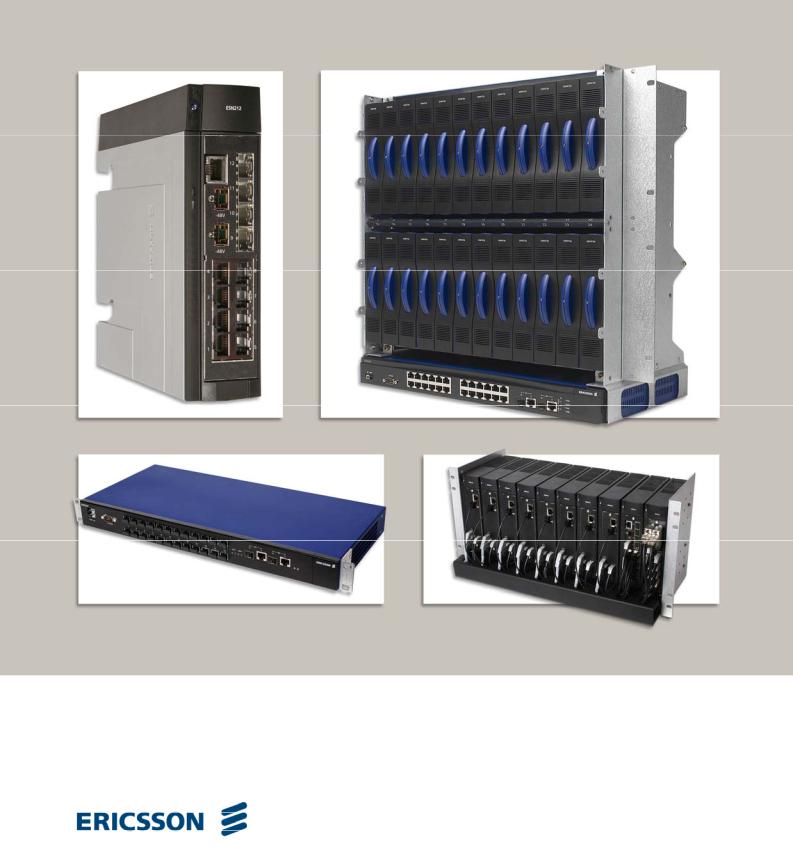
SOLUTION DESCRIPTION
EDA 1200 4.0

Introduction
Broadband access is known to be the fastest growing technology in the telecommunications history.
With the EDA broadband access concept, Ericsson has for several years demonstrated technology leadership on the broadband market — First, by introducing the world’s first Ethernet-based IP DSLAM, then by constantly adding new and innovative features to secure an optimal end-to-end solution.
Now Ericsson takes the next step by introducing a costefficient, environmentally hardened VDSL2 solution. Ideal for fiber-deep deployment close to the end-user and perfectly suited for migration on existing installations, as well as for new customers.
Since the early EDA 1200 days, Ericsson has been shaping and promoting the IP and Ethernet-based architecture. The Ethernet-based architecture (TR-101) has been standardized by DSL Forum, and is seen as the future architecture for telecom operators for years to come.
Market shares have been constantly growing with EDA 1200 and leading European customers have selected EDA 1200 as their preferred technology.
2
Main features
•Modular access node structure
−Unique scalability in steps of 12 lines reduces sleeping investments to an absolute minimum
−Flexible combination of VDSL2 and ADSL/ADSL2/ADSL2+ on remote sites
−Multimode IP DSLAM
−Support of all VDSL2 profiles in the same Hardware (30a not supported)
•Flexible topology support
−Efficient management of remote sites
−Easy deployment close to the end-user
−Migration/upgrade path for VDSL2
−Fiber and copper access
•Environmentally hardened VDSL2 solution
−Extended temperature range -40°C to +75°C without any additional protection.
−Withstand contaminant, solid objects and humidity
−Robust IP44 compatible design
−Ideal for remote application in outdoor cabinet
−Reduced cost of outdoor cabinets
•Intelligent access node
−Advanced service mapping and quality of service features
−Offering bridged and routed service connectivity
•Cost effective solution
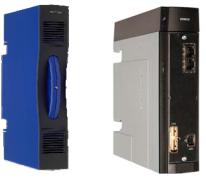
EDA 1200 overview
The EDA 1200 solution (previously called EDA Box) deploys an access network with switched Ethernet and a number of access drop technologies. The following sections describe the components of the EDA 1200 solution with emphasis on the cornerstone of the system - the IP DSLAM.
EDA components
The EDA solution comprises a number of components that allows telecom operators to offer a full-featured access solution:
•12, 96, 144 and 288-line ADSL/ADSL2/ADSL2+ IP DSLAMs (EDN312, EDN144 and EDN288)
•24-port fiber access nodes (EFN324f, EFN324df and EFN324c)
•24-port Ethernet Controller Node (ECN330)
•8-port and 24-port Ethernet switches with power over Ethernet (ESN108 and ECN330 in switch mode)
•12 port Gigabit Ethernet aggregation switch (ESN410)
•2-port Ethernet Power Nodes (EPN102)
•Fast Ethernet to E1/T1 converter (EXN104)
EDA 1200 4.0 introduces a new generation specialized for VDSL2 rollout. The new EDA 1200 is environmental hardened and presents a new look and feel as well as new broadband features:
•12-line VDSL2 IP DSLAM (EDN612)
•12 port Gigabit Ethernet aggregation switch (ESN212)
•10-port Ethernet Power Node (EPN210)
•24-port cat5 access node (EFN324c)
•24-port fiber access node for multimode/dual fiber (EFN324df)
IP DSLAM EDN312x (left) of the existing EDA 1200 product line (the “blue box“) next to the new generation of EDA 1200, the environmental hardened IP DSLAM EDN612 (right).
IP DSLAM with high functionality
The EDA 1200 IP DSLAM is available as a complete all- in-one system with a unique scalability from 12 to 288 lines. The IP DSLAM is built on Ethernet technology (TR-101). In essence, the IP DSLAM terminates the DSL line, and aggregates the traffic into the access network using standard Ethernet uplink connections.
The limited physical dimensions of the EDA 1200 IP DSLAMs are secured without compromising functionality. On the contrary, the IP DSLAM is fully functional and designed using state-of-the-art components, enabling easy SW updates for new functionality support.
The IP DSLAM complies with all relevant DSL standards, and interoperability is constantly verified against the world’s leading CPE modem and chipset vendors. All the DSL line coding is included in one software package, making updates easy to administrate. EDA 1200 supports VDSL2 as well as asymmetric ADSL, ADSL2, and ADSL2+ including:
•VDSL2 Annex A for North America (POTS and ISDN)
•VDSL2 Annex B for Europe (POTS and ISDN)
•ADSL Annex A for POTS support
•ADSL Annex B for ISDN support
•ADSL Annex M for support of enhanced upstream
•ADSL Annex L for Reach Extended
EDA 1200 provides an option for enabling L2 power down per line, which makes it possible for the operator to save up to 25% on the power budget for a complete IP DSLAM. The most significant benefit is obtained when the lines are trained to maximum speed and the CPE is at a distance of 10,000 feet from the IP DSLAM.
EDA 1200 allows PSD shaping to optimize the power distributed from the IP DSLAM. This option is used when an operator has both central-based equipment and remote-based equipment in the network. The solution offers six fixed options: two for standard, two for central-based, and two for remote-based equipment. Radio frequency interference notching makes it possible to restrict parts of the frequency band when training the DSLAM for the requested bandwidth.
The IP DSLAM is an environmentally friendly product, designed in accordance with the ISO14001 standard and produced with regards to a minimum use of lead and halogens in the product. The IP DSLAM conforms to the rigid Bellcore GR-63-core.
3
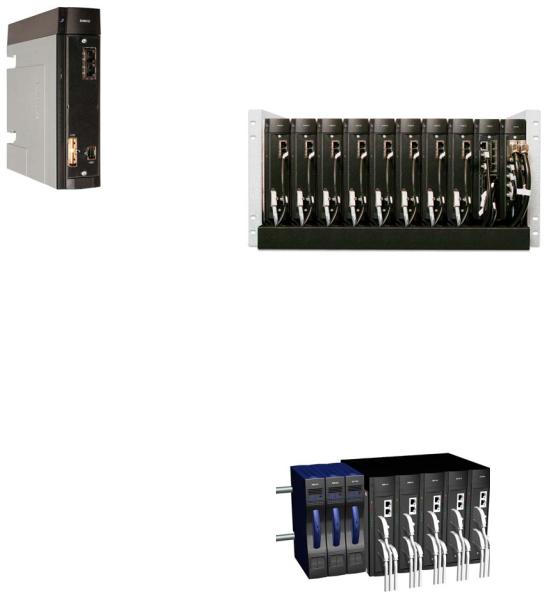
Solutions with IP DSLAM EDN612
The 12-line IP DSLAM EDN612 is the cornerstone of the new EDA 1200 product line specialized for VDSL2 rollout with a fallback option for ADSL/ADSL2/ADSL2+. EDN612 is supported by the 12-port Gigabit aggregation switch ESN212; and together they form an unmatched scalability and deployment opportunity. This new generation of EDA 1200 is environmental hardened and designed for cost-effective installation close to the end-users in remote outside plants, where it demands very little protection against weather and rough environments.
12-line VDSL2 IP DSLAM EDN612
EDN612 has 12 fully flexible lines capable of running VDSL2, ADSL, ADSL2 or ADSL2+. EDN612 is available with POTS front-end (EDN612p) or ISDN front-end (EDN612i). Underlying POTS or ISDN services are available with external splitter, and EDN612 is also prepared for built-in splitter. Two electrical Gigabit uplink connections that can be used for redundancy ensure non-contention operation. EDN612 has a separate connector for -48 V powering (Power over Ethernet is not included in this product line). EDN612 is rail mounted like the existing EDA 1200 product line.
Environmental aspects
The new generation of EDA 1200 is designed for operation under extreme conditions (ETSI EN 300 019- 1-3 Class 3.3 and GR-3108 CORE class 3) in order to meet the requirement for VDSL2 equipment to be pushed even closer to the end-user than ever before. Hence, EDA 1200 can be placed in non-controlled roadside cabinets and other locations with high humidity, dust and dirt, as well as the operating temperature range cover temperatures from -40°C to +75°C, thanks to an optimized cooling channel that easily transports dissipated heat out of the box. In fact, the only protection needed is shelter against rain, direct sunlight, and objects of 1 mm and greater.
POTS and ISDN services
For the support of underlying telephony services POTS and ISDN a external splitter solution is available as well, compliant to the EDA installation method.
Subrack solutions with EDN612
Both 19” and ETSI (21”) wide subracks are available for up to 96 subscriber lines per subrack. Subracks include built-in cable management and air guides and it is possible to mix EDN612 IP DSLAMs, ESN212 switches, and external splitters. An optional Power Distribution Node EPN210 is also available, which also opens the possibility of aggregating EDN312 IP DSLAMs for a cost-efficient ADSL2+/VDSL2 upgrade of a remote site.
Below is shown a fully equipped 96-line ETSI subrack solution without splitters equipped with eight EDN612 IP DSLAMs, one ESN212 switch, and one EPN210 power distribution node.
96-line ETSI subrack with EDN612, ESN212 and EPN210
Migration from existing installed base
EDA 1200 meets the operator’s need for smooth VDSL2 rollout on remote outside plants. The new EDA 1200 designed for VDSL2 rollout is not only a stand-alone product line; it also goes nicely in line with the existing installed base of EDA 1200. The illustration below shows the existing EDA 1200 on the left next to the new generation EDA with front cabling.
Coexistence between the existing and the new EDA 1200
showing EDN312x on the left and EDN612 on the right
4
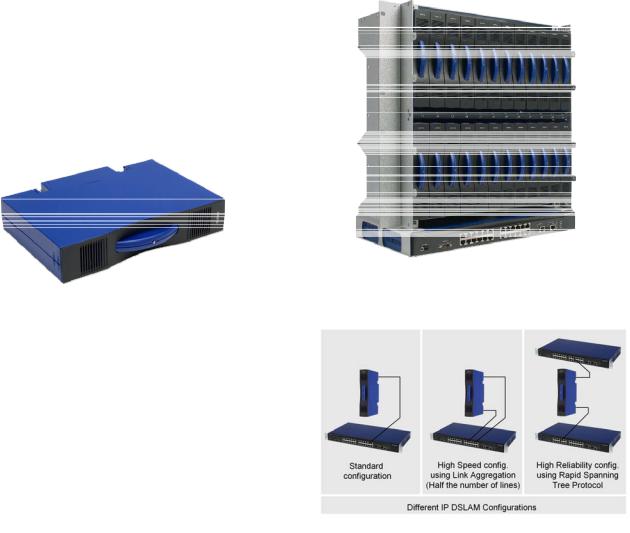
Solutions with IP DSLAM EDN312
The 12-line IP DSLAM EDN312x is the cornerstone of the existing EDA 1200 product line (the “blue Box”) and it provides full support for ADSL, ADSL2 and ADSL2+. The 12-line IP DSLAM EDN312x aggregates all the incoming ADSL links onto one or two 100Base-T Ethernet connections depending of the bandwidth demand.
One innovative aspect of IP DSLAM EDN312x is the power feeding over Ethernet (PoE). Another innovative feature of the EDN312x is the built-in Central Office (CO) base-band filter, available in both POTS (cost-effective POTS, ETSI POTS, and ANSI POTS) and ISDN versions. EDN312x is also available in a version with ISDN high pass filter and no low pass filter. The integrated baseband filter enables base-band telephony.
IP DSLAM EDN312x allows bonding of up to six lines in order to provide high bandwidth to end-users, even to end-users located at distances above 1.6 km. Line bonding is a technique that allows the use of several physical twisted copper pairs as if they form one single line, provided that this is also supported in the CPE.
The scalable IP DSLAM concept is built from a combination of the 12-line IP DSLAMs and the Ethernet Controller Nodes — with the possibility of using the 8- port switch ESN108 for aggregation in between.
The system can be configured in various ways:
•EDN144x:
144-line IP DSLAM built from one ECN330 and 12 EDN312x IP DSLAMs (link aggregated configuration using both uplinks from the IP DSLAM)
•EDN288x:
288-line IP DSLAM built from one ECN330 and 24 EDN312x IP DSLAMs. For redundancy, the 288-line IP DSLAM can be expanded with an additional Ethernet Controller Node (ECN330), as shown below.
288-line IP DSLAM EDN288x - one fully assembled unit.
12-line IP DSLAM EDN312x with built-in base-band filter.
The front end of IP DSLAM EDN312x is well integrated with standard building practice in the sense that it has built-in Gas Discharge Tube (GDT) and Over Voltage Protection (OVP), which means that the IP DSLAM can operate as the primary protection.
Pre-configured solutions with EDN312
EDA 1200 is available as a pre-configured solution. Ordered, delivered, installed, and commissioned as one fully assembled unit, the system ensures easy and trouble-free installation.
5
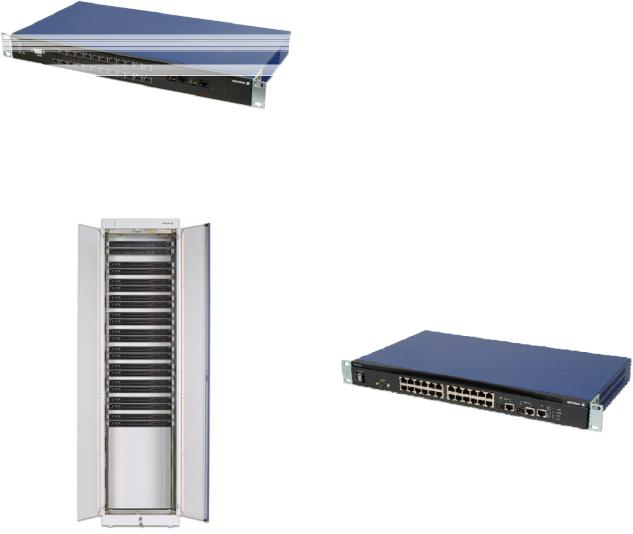
Solutions for fiber and Cat5
EFN324 is the cornerstone of Ericsson's fiber access portfolio, targeting residential end-users, small offices/home offices (SOHO), and small to medium enterprises (SME).
EFN324 is a multi-functional, optical fiber access node that supports triple play services, including multicast video streaming with IGMP snooping.
EFN324 provides 24 x 100 Mbps Fast Ethernet downlink ports and two combo GbE uplink ports. EFN324 is prepared for 19” rack mounting.
EFN324 is available in three variants:
•Single mode single fiber (EFN324f)
•Multi mode dual fiber (EFN324df)
•Cat5 (EFN324c)
EFN324f with 24 optical ports
Combined with the Ethernet aggregation switch ESN410, a large scale, cost-efficient fiber node is easily built, supporting Single Mode/Single Fiber (SM/SF), Multi Mode/Dual Fiber (MM/DF) and Cat5.
Controller Nodes and Ethernet switches
The EDA solution offers a unique suite of 1st and 2nd level Ethernet aggregation switches and Controller Nodes. The Ethernet Controller Nodes are equipped with EDA Management Proxy (EMP) for local management of subtended nodes. The Ethernet switches and Controller Nodes are all managed by the Public Ethernet Manager (PEM), using the Ethernet connection for both user traffic and management traffic.
The portfolio comprises the following products:
•ECN330; 24-port electrical Ethernet Controller Node with two combo GbE uplinks and one electrical GbE uplink. Includes standard switch functionality when EMP is disabled.
•ESN212; 12 port Gigabit Ethernet switch with 8 electrical GbE ports and 4 SFP ports.
•ESN410; 12-port Gigabit Ethernet switch with 8 SFP and 4 combo ports
•ESN108; 8-port electrical Ethernet switch with optical uplink (FE/GbE)
ECN330 and ESN108 include integrated Power over Ethernet (PoE) functionality for powering the connected IP DSLAMs.
For installations, where the IP DSLAM is not connected to a switch with built-in Power over Ethernet (PoE), a separate Ethernet Power Node, (EPN210 or EPN102) can be used, however, the VDSL2 IP DSLAM (EDN612) may also be powered separately.
Ethernet Controller Node ECN330
The Ethernet Controller Node ECN330 is a combined management and traffic aggregation nodes. On the outside, the Ethernet Controller Node looks like an ordinary Ethernet switch, however, as the name indicates, it includes more functionality.
Ethernet Controller Node ECN330
6

The most significant feature is the integrated EDA Management Proxy (EMP) functionality. EMP enables the Ethernet Controller Node to reduce management of IP addresses to just one management IP address per Ethernet Controller Node, independent of the number of subtended IP DSLAMs.
Ethernet Controller Node ECN330 is a natural aggregation point for the EDA 1200 series of IP DSLAMs based on EDN312x, as it contains 24 100 Mbps Fast Ethernet downlink ports.
Combined with ESN410/ESN212 for traffic aggregation, ECN330 may also be used for management of VDSL2 nodes or combined ADSL/VDSL nodes in fixed or flexible topology scenario.
ECN330 is equipped with the built-in EDA Management Proxy (EMP) that is capable of managing up to 250 embedded nodes or 2500 VDSL2/ADSL2+ lines.
ECN330 can also be used as a regular Ethernet switch, as it is possible to disable the EDA Management Proxy (EMP) by command either for all ports or on a per-port basis.
The Ethernet Controller Node offers the following functionality - all in one box:
•Aggregation switch
•24 electrical Fast Ethernet ports
•Two combo uplink ports, either as
−Two electrical 10/100/1000 Mbps or as
−Two 100/1000 Mbps optical SFP
•One electrical 10/100/1000 Mbps uplink (ECN330)
•Built-in Power over Ethernet
•EDA Management Proxy (EMP) application designed to aggregate management traffic from all EDA elements attached
−The EMP allows daisy-chaining of up to 7 ECN330 switches for increased management capacity
−Management of up to 250 embedded nodes or 2500 VDSL2/ADSL2+ lines
−One IP address
•Downgrading to basic switch functionality by disabling EMP
•L2MPLS (Martini draft) for tunneling (ECN330)
•Layer 3 routing features (ECN330)
Aggregation Ethernet switch ESN212
The 12-port Gigabit Ethernet aggregation switch ESN212 is part of the new generation EDA 1200 series — designed for installation in rough environments close to the end-user.
Ethernet switch ESN212 is a 1st level aggregation switch with eight electrical Gigabit Ethernet ports, four optical Gigabit SFP ports and two separate connectors for redundant -48V powering.
ESN212 is rail-mounted and hence ideal for placing in a remote cabinet aggregating up to eight IP DSLAMs (EDN612 as well as EDN312) on the electrical Gigabit ports, using one or more of the optical ports for uplink connection to the central office. ESN212 could, however, also be part of a fiber ring topology, utilizing 2 or more of the 4 optical SFP ports.
ESN212 is equipped with a DIP-switch that allows the telecom operator to assign a unique identifier to the switch for operation in a flexible topology setup with ECN330.
Aggregation Ethernet switch ESN108
Ethernet switch ESN108 is a 1st level aggregation switch with eight electrical Fast Ethernet ports and one optical uplink port. ESN108 will detect the uplink capacity from the SFP module installed and configure the uplink accordingly for 100 Mbps Fast Ethernet or 1 Gbps Ethernet.
7
